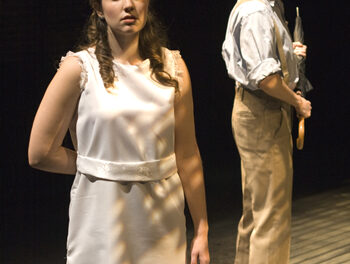You could hardly ask for better vehicles for enabling the orchestra players to show their best wares. Meymandi Concert Hall hosted the latest edition of Duke Medicine Classical Series. Featured were the North Carolina Symphony players themselves, unalloyed and unassisted by any visiting soloist. Contributing powerfully to the evening’s proceedings was guest conductor, Andrea Quinn. Having begun her career at London’s Royal Academy of Music, she comes to North Carolina by way of numerous and prestigious world venues.
She chose the Overture to Wagner’s The Flying Dutchman as opener, a piece in which the players took the listener through huge ocean swells and into placid waters. They brought to bear all the power that one associates with that familiar treasure.
Leaned down from full bore to a good-sized chamber group, the musicians next jumped rather far back in orchestral history to Haydn’s Symphony No. 49, “La Passione.” This mid-career work of the composer opened surprisingly with the slow Adagio, a movement so “unHaydnesque” that it could have come along a hundred years later. Here and in the opening Wagner overture, the conductor impressed by leading without score. She has conducted the entire Dutchman opera, but it’s less obvious why she would have been so familiar with the Haydn piece.
Reports suggest that Andrea Quinn is embarrassed when note is taken of her animated conducting style. She needn’t be. Her athleticism on the podium comes across as entirely natural and quite effective in making known her desires to the players. There seems to be no “Just look at me!” quality, and besides, the time she needs to spend in the gym is minimized.
Anyone familiar with Elgar mainly from his “Enigma Variations” and the “Cockaigne Overture” was in for a pleasant surprise with this conductor’s reading of the composer’s Symphony No. 1 in A-flat, Op. 55. Anecdotal evidence indicated that few in the audience were familiar with this symphony. Here was a gigantic work in the sense of Mahler and Bruckner, employing like forces. Speaking of which, let the fine program notes tell you of the instruments involved: “This work is scored for flutes and piccolo, oboes and English horn, clarinets including bass clarinet, bassoons including contrabassoon, horns, trumpets, trombones including bass trombone, tuba, tympani plus a small battery of percussion, harps and strings.”
A great deal of this piece, a product of Elgar’s “mature” years, could have been inspired (consciously or not) by Mahler’s somewhat earlier Symphony No. 1, the “Titan.” In fact, if the imagination was allowed to wander during the huge opening Andante, one could detect shades of the Eastern exoticism that characterized the Mahler work. The piece provided a sonic treat throughout, particularly where the thundering Allegro molto movement segued so gracefully into a calm Adagio so reminiscent of fellow countryman Vaughan Williams.
It’s possible that these players have never sounded better. As a result of this program, Elgar’s standing hereabouts should be notably enhanced, no longer just a mandatory adjunct to certain graduation ceremonies. The appreciative audience was well served by the selections and the performances. Let’s hear it for the honored visitor and for the level of excellence displayed by conductor and musicians alike.











